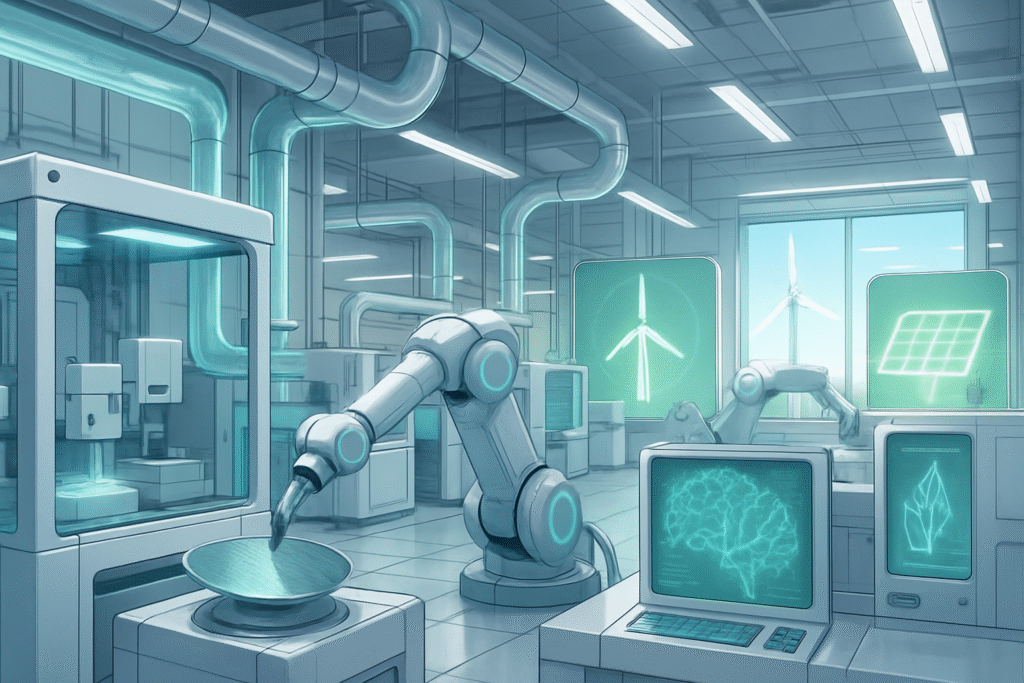
The semiconductor industry, the silent engine of our digital age, is undergoing a profound transformation. Once primarily focused on raw performance and miniaturization, chip manufacturing is now urgently embracing sustainability and green initiatives. This critical shift is driven by the industry's colossal environmental footprint—consuming vast amounts of energy, water, and chemicals while generating significant greenhouse gas emissions—and the escalating demands of power-hungry Artificial Intelligence (AI) technologies. The immediate significance of this pivot extends beyond environmental stewardship; it's a strategic imperative for economic viability, regulatory compliance, and maintaining competitive advantage in a world increasingly prioritizing Environmental, Social, and Governance (ESG) factors.
With the global chip market projected to exceed $1 trillion by 2030, the environmental stakes are higher than ever. Nearly 75% of a mobile device's carbon footprint is linked to its fabrication, with almost half of that coming directly from chip manufacturing. This urgent embrace of sustainable practices is not merely an ethical choice, but a strategic imperative for the industry's long-term survival, profitability, and its crucial role in building a greener global economy.
Engineering a Greener Microcosm: Technical Innovations in Sustainable Chip Production
The semiconductor industry is deploying a sophisticated arsenal of technical advancements and green initiatives to mitigate its environmental impact, marking a significant departure from older, less ecologically conscious manufacturing paradigms. These innovations span energy efficiency, water recycling, chemical reduction, renewable energy integration, and entirely new manufacturing processes.
In energy efficiency, modern "green fabs" are designed with optimized HVAC systems, energy-efficient equipment like megasonic cleaning tools, and idle-time controllers that can reduce tool power consumption by up to 30%. The adoption of advanced materials such as silicon carbide (SiC) and gallium nitride (GaN) offers superior energy efficiency in power electronics. Furthermore, the relentless pursuit of smaller process nodes (e.g., 5nm or 3nm) inherently reduces leakage currents and power dissipation. AI-powered Electronic Design Automation (EDA) tools are now crucial in designing chips for optimal "performance per watt." While energy-intensive, Extreme Ultraviolet (EUV) lithography reduces the number of multi-patterning steps, leading to overall energy savings per wafer for advanced nodes. This contrasts sharply with older fabs that often lacked integrated energy monitoring, leading to significant inefficiencies.
Water recycling is another critical area, given the industry's immense need for ultrapure water (UPW). Companies are implementing closed-loop water systems and multi-stage treatment processes—including reverse osmosis, ultra-filtration, and ion exchange—to purify wastewater to UPW quality levels. Less contaminated rinse water is recycled for wafer processing, while other treated streams are reused for cooling systems and scrubbed exhaust systems. This drastically reduces reliance on fresh municipal water, a stark difference from older methods that largely discharged wastewater. Companies like Taiwan Semiconductor Manufacturing Company (NYSE: TSM) (TSMC) reused 67% of its total water consumption in 2019, while Samsung (KRX: 005930) has achieved over 70% recycling rates.
Chemical reduction efforts are centered on "green chemistry" principles. This involves developing eco-friendly materials and solvents, such as aqueous-based cleaning solutions, to replace hazardous traditional solvents. There's a concerted effort to reduce the use of high Global Warming Potential (GWP) gases like PFCs and nitrogen trifluoride (NF3), either by finding alternatives or improving process equipment to reduce consumption. Closed-loop chemical recycling and onsite blending further minimize waste and transportation emissions. Older methods were far more reliant on a wide array of toxic substances with less emphasis on recycling or safer alternatives.
The shift towards renewable energy is also accelerating. Fabs are integrating solar, wind, and hydroelectric power, often through on-site installations or large corporate power purchase agreements. Major players like Intel (NASDAQ: INTC) have achieved 93% renewable energy use in their global operations as of 2023, with TSMC aiming for 100% renewable energy by 2040. This is a dramatic departure from the historical reliance on fossil fuels.
Finally, innovative manufacturing processes are being reimagined for sustainability. AI and Machine Learning (ML) are central to "smart manufacturing," optimizing resource usage, predicting maintenance, and reducing waste in real-time. Advanced packaging technologies like 3D integration and chiplet architectures minimize power consumption in high-performance AI systems. Researchers are even exploring water-based nanomanufacturing and advanced carbon capture and abatement systems to neutralize harmful emissions, moving towards a more holistic, circular economy model for chip production.
The Competitive Edge of Green: Impact on Tech Giants and Innovators
The imperative for sustainable chip manufacturing is fundamentally reshaping the competitive landscape for AI companies, established tech giants, and burgeoning startups. This shift is not merely about compliance but about securing market leadership, attracting investment, and building resilient supply chains.
Tech giants like Apple (NASDAQ: AAPL), Google (NASDAQ: GOOGL), Microsoft (NASDAQ: MSFT), and Dell Technologies (NYSE: DELL) are exerting significant pressure on their semiconductor suppliers. With their own aggressive net-zero commitments, these companies are driving demand for "green chips" and often tie contracts to sustainability performance, compelling manufacturers to adopt greener practices. This enhances their brand reputation, improves ESG scores, and attracts environmentally conscious customers and investors. Companies like NVIDIA (NASDAQ: NVDA) are also adopting renewable energy for their production processes.
Leading chip manufacturers that are proactive in these initiatives stand to gain immensely. Intel (NASDAQ: INTC) aims for 100% renewable electricity by 2030 and net-zero Scope 1 and 2 greenhouse gas emissions by 2040, leveraging AI for chip design optimization. TSMC (NYSE: TSM) is committed to 100% renewable energy by 2040 and is a pioneer in industrial reclaimed water reuse. Samsung Electronics (KRX: 005930) is pursuing carbon neutrality by 2050 and developing low-power chips. Micron Technology (NASDAQ: MU) targets net-zero greenhouse gas emissions by 2050 and 100% water reuse/recycling by 2030, with products like HBM3E memory offering reduced power consumption. These companies gain significant cost savings through efficiency, streamline regulatory compliance, differentiate their products, and attract capital from the growing pool of ESG-focused funds.
For AI companies, the demand for ultra-low power, energy-efficient chips is paramount to power "green data centers" and mitigate the environmental impact of increasingly complex AI models. Ironically, AI itself is becoming a crucial tool for sustainability, optimizing manufacturing processes and identifying efficiency gaps.
Startups are finding fertile ground in this green revolution. New market opportunities are emerging in areas like sustainable product features, green chemistry, advanced materials, resource recovery, and recycling of end-of-life chips. Startups focused on cooling technology, PFAS remediation, and AI for manufacturing optimization are attracting significant corporate venture investment and government funding, such as the "Startups for Sustainable Semiconductors (S3)" initiative.
This shift is causing disruption to traditional processes, with green chemistry and advanced materials replacing older methods. New market segments are emerging for "green data centers" and low-power memory. The industry is moving from a "performance-first" mentality to one that balances cutting-edge innovation with environmental stewardship, positioning companies as leaders in the "Green IC Industry" to secure future market share in a global green semiconductor market projected to reach $382.85 billion by 2032.
A Broader Canvas: The Wider Significance in the AI Era
The drive for sustainability in chip manufacturing is far more than an industry-specific challenge; it's a critical component of the broader AI landscape and global sustainability trends, carrying profound societal and environmental implications.
The environmental impact of the semiconductor industry is immense. It consumes vast amounts of energy, often equivalent to that of small cities, and billions of liters of ultrapure water annually. The use of hazardous chemicals and potent greenhouse gases, like nitrogen trifluoride (NF3) with a global warming potential 17,000 times that of CO2, contributes significantly to climate change. The rapid advancement of AI, particularly large language models (LLMs), exacerbates these concerns. AI demands immense computational resources, leading to high electricity consumption in data centers, which could account for 20% of global electricity use by 2030-2035. TechInsights forecasts a staggering 300% increase in CO2 emissions from AI accelerators alone between 2025 and 2029, highlighting the dual challenge of AI's "embodied" emissions from manufacturing and "operational" emissions from its use.
Societal impacts include improved public health for communities near fabs due to reduced hazardous waste and air pollution, as well as addressing resource equity and depletion concerns, especially regarding water in arid regions. While not explicitly detailed in the research, sustainable manufacturing also implies ethical sourcing and fair labor practices across the complex global supply chain.
This fits into the broader AI landscape through the burgeoning "Green AI" or "Sustainable AI" movement. As AI models grow in complexity, their energy demands grow exponentially. Sustainable chip manufacturing, through energy-efficient chip designs, advanced cooling, and optimized processes, directly tackles AI's operational carbon footprint. Green AI aims to minimize the ecological footprint of AI throughout its lifecycle, with sustainable chip manufacturing providing the essential hardware infrastructure. Paradoxically, AI itself can be a tool for sustainability, optimizing fab operations and designing more energy-efficient chips.
However, potential concerns persist. The complexity and cost of switching to sustainable processes, the risk of "greenwashing," and the historical trade-offs between performance and sustainability are significant hurdles. The global and concentrated nature of the semiconductor supply chain also makes oversight challenging, and the pace of adoption can be slow due to the difficulty and cost of replacing existing manufacturing processes.
Compared to previous AI milestones, the current focus on sustainability is far more urgent and explicit. Early AI systems had minimal environmental impact. Even in the early machine learning era, while energy efficiency was a concern, it was often driven by consumer demands (e.g., battery life) rather than explicit environmental sustainability. The "carbon footprint" of AI was not a widely recognized issue. Today, with deep learning and generative AI models demanding unprecedented computational power, the environmental implications have shifted dramatically, making sustainability a central theme and a strategic imperative for the industry's future.
The Horizon of Innovation: Future Developments in Sustainable Chip Manufacturing
The trajectory of sustainable chip manufacturing points towards a future where environmental responsibility is intrinsically woven into every facet of technological advancement. Both near-term and long-term developments are poised to redefine how semiconductors are produced and consumed.
In the near term (1-5 years), the industry will focus on accelerating the adoption of existing sustainable practices. This includes the widespread integration of renewable energy sources across fabrication plants, with leading companies like TSMC (NYSE: TSM) and GlobalFoundries (NASDAQ: GFS) setting aggressive net-zero targets. Improved water management will see advanced water reclamation systems becoming standard, with companies achieving high recycling rates and complying with stricter regulations, particularly in the EU. A decisive shift towards green chemistry will involve replacing hazardous chemicals with safer alternatives and optimizing their usage, including exploring fluorine (F2) gas as a zero GWP alternative. Energy-efficient chip designs and manufacturing processes, heavily aided by AI and machine learning for real-time optimization, will continue to evolve, alongside the installation of advanced abatement systems for GHG emissions. The adoption of circular economy principles, focusing on recycling, remanufacturing, and reuse, will become more prevalent, as will the research and integration of eco-friendly materials like biodegradable PCBs.
Long-term developments (5+ years) envision more transformative changes. This includes a deeper integration of the circular economy, encompassing comprehensive waste reduction and carbon asset management. Novel materials and designs will enable consumers to more easily reduce, reuse, recycle, repair, and upgrade microchip-containing systems. Advanced packaging technologies like 3D integration and chiplets will become standard, minimizing power consumption. Given the immense power demands of future AI data centers, nuclear energy is emerging as a long-term, environmentally friendly solution, with major tech companies already investing in this area. Photonic integration will offer high-performance, lower-impact microchip technology, and advanced abatement systems may incorporate Direct Air Capture (DAC) to remove CO2 from the atmosphere.
These advancements will enable a host of potential applications. They are crucial for energy-efficient AI and data centers, mitigating the environmental burden of rapidly expanding AI models. Sustainable chips are vital for clean energy systems, optimizing solar, wind, and energy storage infrastructure. In smart mobility, they drive innovation in electric vehicles (EVs) and autonomous systems, leveraging wide-bandgap semiconductors like GaN and SiC. They also enable smarter manufacturing through IoT, optimizing production and conserving resources, and lead to greener consumer electronics with reduced carbon footprints and recyclable materials.
However, significant challenges remain. The inherently high energy and water consumption of advanced fabs, the reliance on hazardous chemicals, and the upfront costs of R&D and new equipment are substantial barriers. Manufacturing complexity, regulatory disparities across regions, and the intricate global supply chain further complicate efforts. Experts predict an acceleration of these trends, with AI becoming an indispensable tool for sustainability within fabs. The sustainable electronics manufacturing market is projected for significant growth, reaching an estimated USD 68.35 billion by 2032. The focus will be on integrated sustainability, where environmental responsibility is fundamental to innovation, fostering a resilient and ethically conscious digital economy through collaborative innovation and smart manufacturing.
The Green Horizon: A Comprehensive Wrap-Up of Chip Manufacturing's Sustainable Future
The semiconductor industry stands at a pivotal moment, where its relentless pursuit of technological advancement must converge with an urgent commitment to environmental responsibility. The push for sustainable chip manufacturing, driven by an escalating environmental footprint, stringent regulatory pressures, investor demands, and the exponential growth of AI, is no longer optional but a strategic imperative that will shape the future of technology.
Key takeaways highlight a multifaceted approach: a paramount focus on resource efficiency (energy, water, materials), rapid integration of renewable energy sources, a decisive shift towards green chemistry and eco-friendly materials, and the widespread adoption of circular economy principles. Energy-efficient chip design and the indispensable role of AI and machine learning in optimizing fab operations are also central. The industry's substantial environmental burden, including 50 megatons of CO2 emissions annually from manufacturing and the significant contribution of high GWP gases, underscores the urgency of these initiatives.
In the history of AI, this sustainability drive marks a crucial turning point. While early AI systems had minimal environmental impact, the current era of deep learning and generative AI has unveiled a profound environmental paradox: AI's immense computational demands lead to an unprecedented surge in energy consumption, making data centers major contributors to global carbon emissions. Consequently, sustainable semiconductor manufacturing is not just an ancillary concern for AI but a fundamental necessity for its ethical and long-term viability. AI itself, in a recursive loop, is becoming a powerful tool to optimize chip designs and manufacturing processes, creating a virtuous cycle of efficiency.
The long-term impact of these efforts promises significant environmental preservation, economic resilience through reduced operational costs, and enhanced competitive advantage for proactive companies. By producing chips with meticulous attention to their environmental footprint, the industry ensures that the foundational components of our digital world are sustainable, enabling the long-term viability of advanced technologies like AI and fostering a truly sustainable digital future. Without these changes, the IC manufacturing industry could account for 3% of total global emissions by 2040.
What to watch for in the coming weeks and months includes the evolution of stricter regulatory frameworks, particularly in Europe with Ecodesign for Sustainable Products Regulation (ESPR) and digital product passports. Expect continued acceleration in renewable energy adoption, with companies prioritizing locations with easier access to green power. Further advancements in water management, including closed-loop recycling and innovative cleaning processes, will be critical. The integration of AI for sustainable operations will deepen, with projects like Europe's GENESIS (starting April 2025) focusing on AI-based models for monitoring and optimizing PFAS emissions. New materials and design innovations, increased focus on supply chain sustainability (Scope 3 emissions), and industry collaboration and standardization initiatives, such as iNEMI's Life Cycle Assessment (LCA) framework (launched May 2024), will also be key indicators of progress. While challenges persist, the industry's commitment to sustainability is intensifying, paving the way for a greener future for semiconductor manufacturing and the broader digital economy.
This content is intended for informational purposes only and represents analysis of current AI developments.
TokenRing AI delivers enterprise-grade solutions for multi-agent AI workflow orchestration, AI-powered development tools, and seamless remote collaboration platforms.
For more information, visit https://www.tokenring.ai/.







